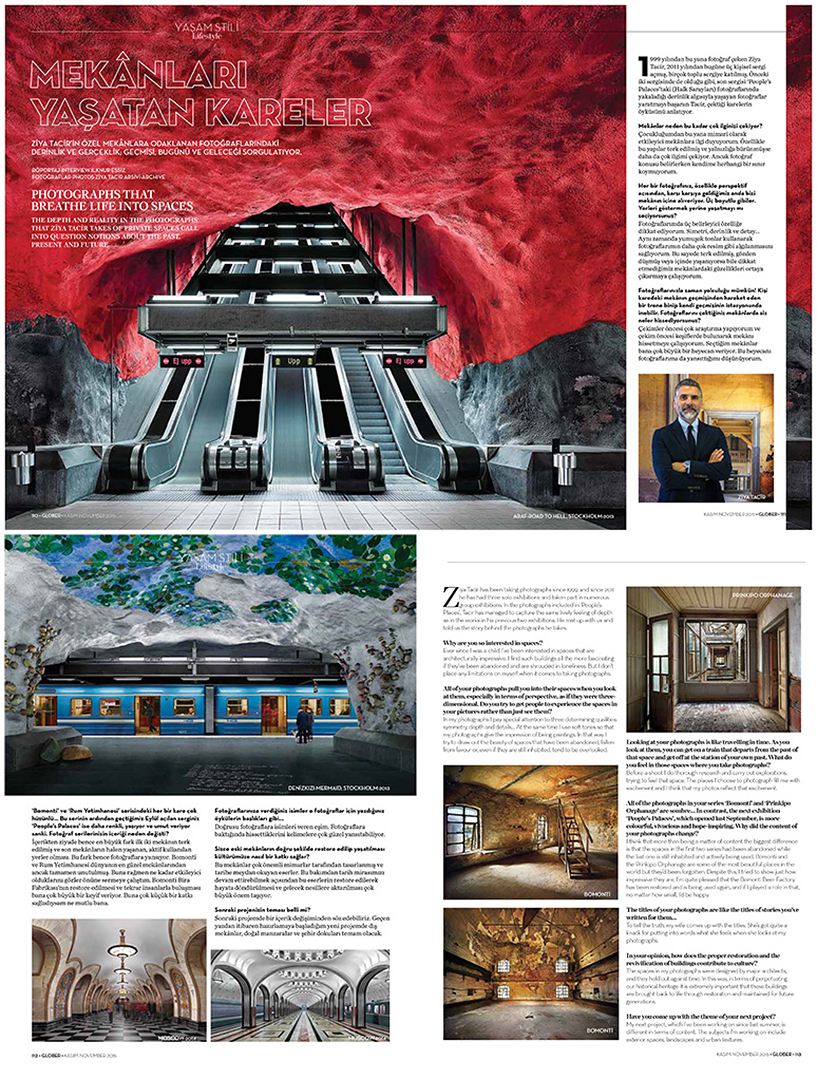
PHOTOGRAPHS THAT BREATHE LIFE INTO SPACE / GLOBER MAGAZINE INTERVIEW, NOVEMBER 2015
Ziya Tacir has been taking photographs since 1999, and since 2011 he has had three solo exhibitions and taken part in numerous group exhibitions. In the photographs included in ‘People’s Places’, Tacir has managed to capture the same lively feeling of depth as in the works in his previous two exhibitions. He met up with us and told us the story behind the photographs he takes.
- Why are you so interested in spaces?
- Ever since I was a child I’ have been interested in spaces that are architecturally impressive. I find such buildings all the more fascinating if they’ ve been abandoned and are shrouded in loneliness. But I don’t place any limitations on myself when it comes to taking photographs.
- All of your photographs pull you into their spaces when you look at them, especially in terms of perspective, as if they were three dimensional. Do you try to get people to experience the spaces in your pictures rather than just see them?
- In my photographs I pay special attention to three determining qualities: symmetry, depth and details... At the same time I use soft tones so that my photographs give the impression of being paintings. In that way I try to draw out the beauty of spaces that have been abandoned, fallen from favor or, even if they are still inhabited, tend to be overlooked.
- Looking at your photographs is like traveling in time. As you look at them, you can get on a train that departs from the past of that space and get off at the station of your own past. What do you feel in those spaces where you take photographs?
- Before a shoot I do thorough research and carry out explorations, trying to feel that space. The places I choose to photograph fill me with excitement and I think that my photos reflect that excitement.
- All of the photographs in your series ‘Bomonti’ and ‘Prinkipo Orphanage’ are sombre... In contrast, the next exhibition ‘People’s Palaces’, which opened last September, is more colourfull, vivacious and hope-inspiring. Why did the content of your photographs change?
- I think that more than being a matter of content the biggest difference is that the spaces in the first two series had been abandoned while the last one is still inhabited and actively being used. Bomonti and the Prinkipo Orphanage are some of the most beautiful places in the world but they’d been forgotten. Despite this, I tried to show just how impressive they are. I’m quite pleased that the Bomonti Beer Factory has been restored and is being used again, and if I played a role in that, no matter how small, I’d be happy.
- The titles of your photographs are like the titles of stories you’ve written for them...
To tell the truth, my wife comes up with the titles. She’s got quite a knack for putting into words what she feels when she looks at my photographs.
- In your opinion, how does the proper restoration and the revivo cation of buildings contribute to culture?
- The spaces in my photographs were designed by major architects, and they hold out against time. In this way, in terms of perpetuating our historical heritage it is extremely important that these buildings are brought back to life through restoration and maintained for future generations.
- Have you come up with the theme of your next project?
- My next project, which I’ve been working on since last summer, is different in terms of content. The subjects I’m working on include exterior spaces, landscapes and urban textures.
